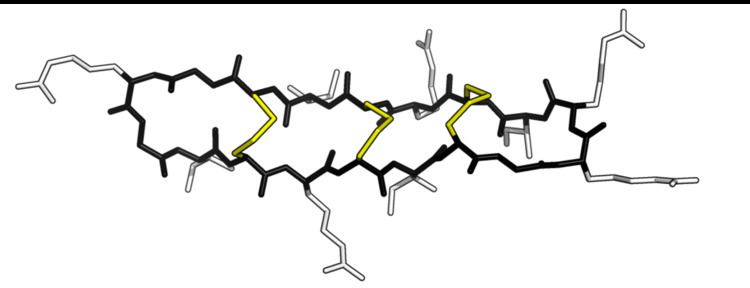Symbol N/A OPM protein 2atg | OPM superfamily 226 | |
 | ||
Theta-defensins (θ-defensins. retrocyclins) are a family of mammalian antimicrobial peptides. They are found in non-human 'Old World' primates, but not in human, gorilla, bonobo, and chimpanzee.
Contents
Structure
θ-defensins are cyclic peptides of 18 amino acids (~2 kDa), possessing antimicrobial activity against a range of Gram-positive and Gram-negative bacteria, fungi, and some retroviruses. They consist of a pair of antiparallel β-sheets linked by three disulphide bonds arranged as a ladder along the sheets to form an extremely stable structure. Additionally, the peptides may self-associate into trimers.
Biosynthesis
In rhesus macaque (Macaca mulatta) and olive baboon (Papio anubis), θ-defensins are produced from 76 amino acid precursor proteins. A single nine amino acid peptide is derived from each precursor. Two of these nine amino acid peptides are spliced together to form the circular 18 amino acid defensin. Since there are two precursor genes (rhesus theta defensin RTD-1 and RTD-2) they can form 3 different mature θ-defensins: the homodimer of processed RTD-1, The homodimer of processed RTD-2 or the heterodimer composed of both precursors. The heterodimeric form is the most abundant.
In the olive baboon, four θ-defensin precursor genes have been isolated: BTD-a, BTD-b, BTD-c and BTD-d, which encode subunits A, B, C and D. These four subunits could theoretically combine to produce 10 different processed defensins. However, only five have been observed: consisting of subunits A+A, A+B, A+C, A+D and B+B (Referred to as BTD-3, BTD-1, BTD-4, BTD7 and BTD-2 respectively). Finally, orangutan genomes encode 4 θ-defensin precursor genes and gibbon genomes encode 2.
Activity
Antimicrobial activity has been reported against:
Antimicrobial activity is generally through binding to and disrupting the cell membrane. Antiviral activity appears to derive from their binding to the sugar component of glycoproteins and blocking the entry of viruses into the cell.
Old World monkey defensins
θ-defensins are extremely divergent members of the defensin protein superfamily which includes alpha-, beta- and big-defensins. The θ-defensins appear to have evolved from α-defensin genes around 40 million years ago in Old World monkeys. The genes were later inactivated in the ancestor of chimpanzees, bonobos, gorillas and humans by mutation that introduced a premature stop codon.
Human retrocyclin pseudogenes
Although New World monkeys and great apes do not produce θ-defensin proteins, human genomes do encode θ-defensin genes which are transcribed to mRNA but not translated due to a premature stop codon. When the mature defensin that would be expressed is chemically synthesised in a laboratory, it shows antimicrobial activity (including anti-retrovirus, leading to the name retrocyclin). It is unknown whether this pseudogenisation gave a selective advantage or was due to genetic drift. The anti-HIV activity of retrocyclins has been further enhanced by protein engineering efforts with the aim of generating a viable treatment.
